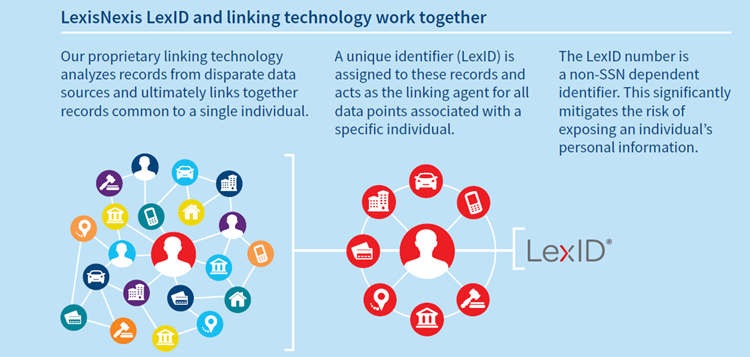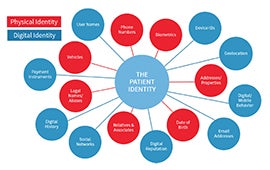LexisNexis® LexID® for Healthcare
Link patient records and improve interoperability
LexID® for Healthcare offers an alternative, unique identifier for patient record matching and interoperability.
The digitization of all forms of data across the healthcare ecosystem in conjunction with the pressure to provide virtual access to that data to multiple stakeholders has proven to be both an opportunity and a risk. In today’s healthcare information environment, it is incumbent upon organizations to look at managing patient information across care settings and platforms as both a business problem and a key enabler for core business functions, interoperability and patient safety. LexID® offers healthcare organizations a persistent key that follows a patient identity throughout its evolution and journey.
How does LexID for healthcare work?
LexisNexis can match patient or member records to one of our LexID profiles and return a unique LexID number for each individual. In turn, these LexIDs allow healthcare organizations to identify duplicate records as well as match and merge like records. A LexID is more secure and unique than a Social Security Number identification system since it can’t be traced back to the individual. With the push for a universal patient identifier, LexID can help meet the need for automated patient matching, relieving the burden and cost of manual matching on staff.

Contact Us to Learn More!
Benefits to Health Plans & PBMs
- Create a more accurate view of member populations by linking together patient records.
- Minimize the exposure of sensitive member data to potential medical identity theft.
- Reduce costs by removing the need to process and store redundant information.
- Maximize automated matching for improved interoperability.
- Leverage as a universal member identifier
Benefits to Providers
- Provides a universal patient identifier to improve patient record matching, reduce duplication enabling interoperability between disparate EMR systems.
- Minimizes patient safety risks by matching the right patient with the right procedure, medication or diagnosis.
- Augment and verify key information in your patient database such as names, addresses, dates of birth and more.
- Provides a true referential, persistent ID system to help secure patient information in electronic health records (EHR) and mobile apps.
Key Features of LexID for Healthcare
- Available via API
- Leverages referential data and matching.
- Identifies relationships between and within entities that are transitive, hidden or not obvious to further improve linking and matching of records to individuals.
- Resolves linking discrepancies due to phonetics or string distance.
- Merges and removes duplicate records.
- Customer Record Key available as an add-on which provides a customer-specific identifier to add extra privacy and to identify every patient, including the unbanked.
Contact Us to Learn More
Products You May Be Interested In
-
InstantID® for Healthcare
Identify fraud risks across exchanges and broker communities
Learn More -
InstantID® Q&A for Healthcare
Seamlessly verifies the identity of patients, medical staff and pharmacists.
Learn More -
Keep Contact
Transform your engagement efforts by improving and maintaining patient and member data.
Learn More
LexID(R) for healthcare provided by LexisNexis is not provided by "consumer reporting agencies," as that term is defined in the federal Fair Credit Reporting Act (15 U.S.C. § 1681, et seq.) (FCRA) and does not constitute a "consumer report," as that term is defined in the FCRA. LexID(R) may not be used in whole or in part as a factor in determining eligibility for credit, insurance, employment or another eligibility purpose that would qualify it as a consumer report under the FCRA. Due to the nature of the origin of public record information, the public records and commercially available data sources used in reports may contain errors. Source data is sometimes reported or entered inaccurately, processed poorly or incorrectly, and is generally not free from defect. This product or service aggregates and reports data, as provided by the public records and commercially available data sources, and is not the source of the data, nor is it a comprehensive compilation of the data. Before relying on any data, it should be independently verified.



